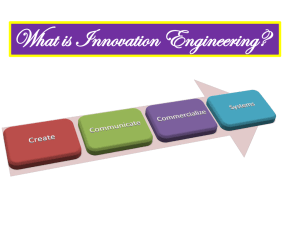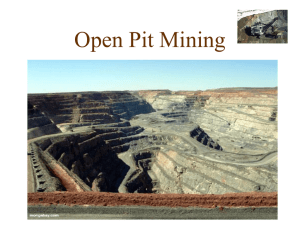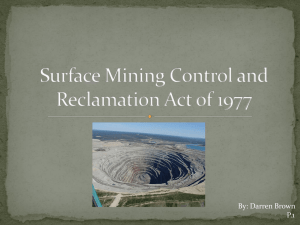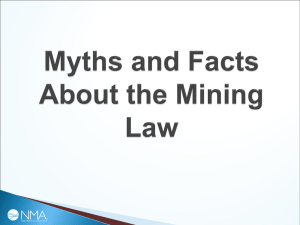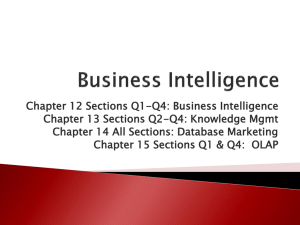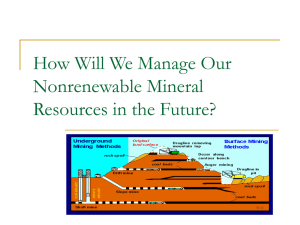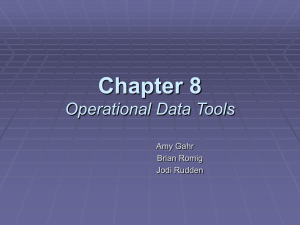General Mining Engineering
advertisement
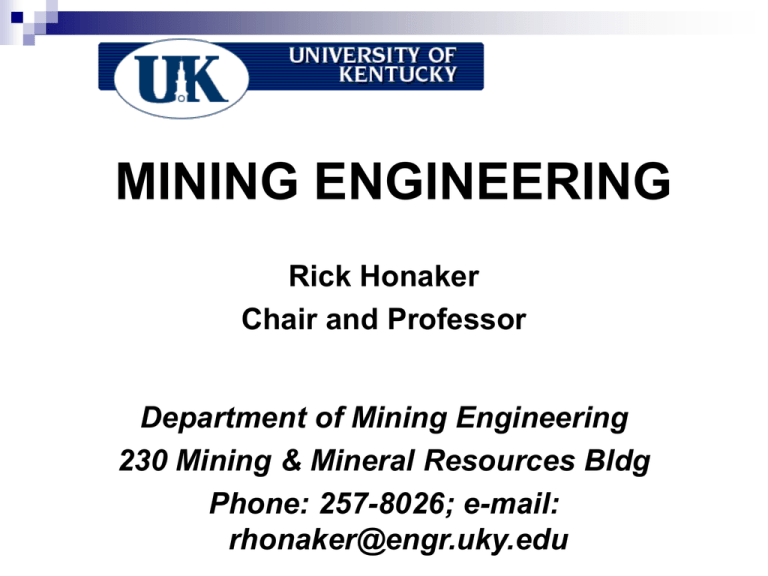
MINING ENGINEERING Rick Honaker Chair and Professor Department of Mining Engineering 230 Mining & Mineral Resources Bldg Phone: 257-8026; e-mail: rhonaker@engr.uky.edu OPPORTUNITIES Demand far exceeds supply for entry-level Mining Engineers Many are unfamiliar with the mining industry and its career opportunities Scholarship opportunities Graduate Mining Engineering Trend The upsurge in mining engineering graduates in the late 1970’s was due to the energy crisis. Downward turn was a correction in the supply vs. demand relationship and low coal and mineral prices. Recent market conditions and future projections indicate an increase in mineral and coal demand. Currently graduating about 140 per year in the U.S.. Study found that 300 new graduates per year will be needed over the next 10 years. Mining Engineer Graduate Demand (5% Growth Scenario) 52% of the mining engineers in the U.S. are over 50 years of age. Based on a retirement age of 65, approximately 300 new mining engineering graduates will be needed over the next 10 years to meet the demand. Career & Salary Growth Potential ‘Show me the money!’ Due to the retirement rate and the growth in the minerals industry, career growth is accelerated. Potential to achieve upper level management position in less than 10 years. Salaries are 2005 data. Current 2007 starting salaries are in the $55,000 - $60,000 range. NATIONAL ENGINEER’S WORKFORCE STATISTICS Software Manu. Ar. Civil Chemical Nuclear Mining Median annual income ($) Petroleum 90000 80000 70000 60000 50000 40000 30000 20000 10000 0 Academic Faculty Opportunities 13 Mining Engineering programs in the U.S.. 69 tenured or tenure track faculty. 24% will retire in the next five years. Near half will retire in the next 10 years. Undergraduate Mining Engineering Scholarships (> 69 credits complete) Math, Chem. Amount per & Physics Semester GPA Level GPA I 3.60 – 4.00 3.20 – 4.00 $3800 II 3.30 – 3.59 3.00 – 3.19 $3400 III 3.00 – 3.29 2.50 – 2.99 $3000 IV 2.70 – 2.99 2.25 – 2.49 $2300 V 2.50 – 2.69 2.25 – 2.49 $1400 UK Undergraduate Enrollment UK Undergraduate Mining Engineering Enrollment 120 101 100 88 80 67 60 51 52 2003 2004 40 20 0 2005 Year 2006 2007 IMPORTANCE OF MINING INDUSTRY-Just about everything! All other industries depend on mining and agriculture Nearly all energy sources are obtained via mining Can you name something you are wearing or something that you have used today that came from the mining industry? About 40,000 pounds of new mineral materials are now required annually for each U.S. Citizen MATERIAL Stone Sand & Gravel Cement Clays Salt Other nonmetals Iron & steel Aluminum LBS 8,260 7,110 690 470 420 1,470 1,190 55 MATERIAL Copper Lead Zinc Other metals Petroleum Coal Gas Uranium LBS 32 15 12 32 8,100 5,590 4,205 0.1 Coal Growth in Electric Generation New Coal-Based Power Generation Units Promising Global Coal Outlook WHAT DOES A MINING ENGINEER DO? Responsible for the safe, economical, and environmentally sound operation of mines. Find, extract, and prepare coal, metals, and minerals for use by manufacturing industries and utilities. Design open pit and underground mines, supervise the construction of mine shafts and tunnels in underground operations, and devise methods for transporting minerals to processing plants. Some develop new mining equipment or direct mineral processing operations to separate minerals from the dirt, rock, and other materials with which they are mixed. VARIOUS SPECIALTY AREAS • • • • • • • • • Ground control and excavation design Ventilation systems design Mineral processing Geological modeling and reserve analysis Power system design Material handling system design Economic feasibility Operations and corporate management Others GEOLOGICAL ENGINEER TYPICAL JOB TASKS 1. Direct drilling programs & apply geological interpretations. 2. Make computerized maps. 3. Applying geological knowledge to directing mining, processing and research groups. 4. Work environment variety: hiking surface, climbing underground, corporate office presentation. MINING ENGINEER TYPICAL JOB TASKS 1. Determine of best mining practice. 2. Minimize ground disturbance. 3. Survey operations to determine production levels. 4. Design explosive and blasting operations. 5. Develop optimum materials handling systems. 6. Evaluate operational efficiency. 7. Develop ventilation & safety engineering strategies. Longwall Mining Underground mining method used in flat lying deposits and mostly in coal. Mines the coal in large blocks of approximately 10000 feet by 1000 feet. Shields (shown in picture) run across the 1000 foot face and support the roof while a shearer removes the coal from the face. As the shields move forward, roof caves in behind. Room-and-Pillar Mining Application in flat lying deposits. Coal, aggregates and minerals extracted using this technique. Extraction achieved by either: 1. Drilling & Blasting or 2. Continuous Miner. Continuous miner cutting and loading coal Roof bolter installing roof bolts for roof support Shuttle car being loaded Shuttle car discharging load Conveyor belt Feeder/breaker Sublevel Caving Underground mining technique for fairly steep deposits (>60o). Weak to strong ore and rock. Typically used for sulfide ores or precious metals. Mining is performed downwards from the top of the ore body. Mineral Processing Engineer TYPICAL JOB TASKS 1. Design the processes & flow sheet needed to produce a valuable material. 2. Develop & direct the processes that separate minerals from other minerals. 3. Optimize processing operations to ensure maximum profitability. 4. Produce a product that can be transported. 5. Apply processing to reduce environmental impacts. In-Situ Rock Breakage 100 tons/hr Run-of-Mine Copper Ore (0.50%) Primary Crusher Typical Mineral Processing Flow Sheet Secondary Crushing Classification Grinding Classification Solid-Solid Separation Solid-Liquid Separation Tailings (0.14% Cu) 98.5 tons/hr Solid-Liquid Separation Copper Concentrate (25% Cu) 1.5 tons/hr Coal Preparation Flow Sheet Small Coarse Size-Size Raw Screens Deslime Screens Solid-Solid Heavy Media Vessel Heavy Media Cyclone Ultrafine Fine Coal Spirals Classifying Cyclones Solid-Liquid Dewatering Screens Basket Centrifuge Screen-Bowl Centrifuges Disc Filter Froth Flotation ENVIRONMENTAL ENGINEER TYPICAL JOB TASKS 1. Ensures that the company is aware of all laws. 2. Designs environmental systems to protect against mishaps that could endanger people and surroundings. 3. Monitors air and groundwater. 4. Develops permits for additional mining and reclamation areas. 5. Directs the reclamation program. 6. Works with public to address environmental issues of mining. CAREER OPPORTUNITIES • Mining has always been among the top paying fields in engineering • Fast career track relative to other fields in engineering • “Boeing assigns 100 engineers to design a $100,000,000 jet. AMAX assigns 3 mining engineers in their 20’s to design a $100,000,000 coal mine.” CAREER OPPORTUNITIES (CONT.) • Fast track from mining engineering to executive positions. • Rural and international living opportunities. Crushed stone mined everywhere. • Overall employment in the industry will decline, but not technical employment. OUR DEPARTMENT • Approximately 105 undergraduates, 18 graduates, 3 post-docs, 8 faculty • 25,259 square feet of space and $1.6 million equipment for teaching. • 60,000 square feet research facility and $7 million advanced research equipment. • Low student to faculty ratio…We get to know you all. OUR DEPARTMENT (CONT.) • Traditional curriculum with opportunities to specialize in mineral processing, power systems, ventilation, geostatistics, system engineering, and other areas. • Summer and co-op employment opportunities are plentiful. Nearly all of our graduates leave with considerable work experience. • Student Chapter of SME ranked among top 2 nationally for each of the last 5 years.

